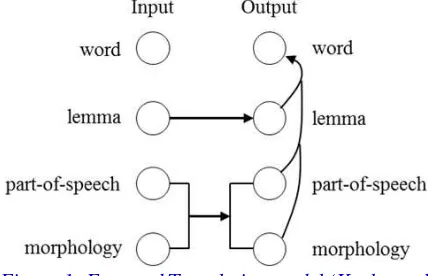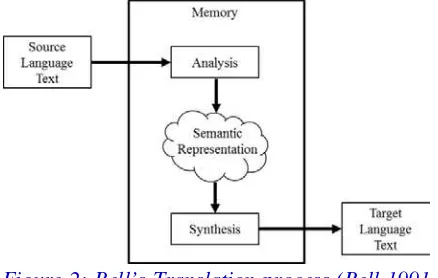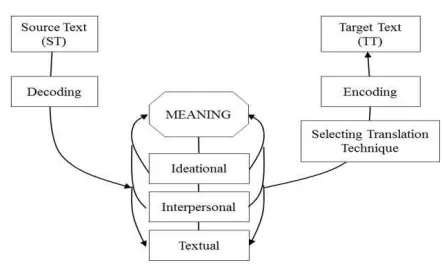ABSTRACT
[PP:75-80]
Dr.Nurlela Dr. RudySofyan,S.S. Dr.Gustianingsih
Department of Linguistics, Faculty of CulturalSciences University of SumateraUtara Medan,Indonesia
One of the ways assisting translators in producing a good target text (TT) is a translation model based on which they do their task comfortably. Designing or developing a model serves as an effort to find the best way to provide full equivalent of the ST in the TT (Vinay and Darbelnet 1995, p. 255) even though there will be no exact equivalent in translation (Nida 1964, p.159). This is a descriptive qualitative study using the book entitled „Hikayat Deli’ written in Malay language and its translation in bahasa Indonesia as the data. In addition, several translation models were revisited as the references as well as the comparative model in order to show how the previous models were different from the present model. The data were analysed using a content analysis and the findings became the basis of developing a translation model. The study has resulted in the formation of „Meaning-Based Translation Model”. This model is extension of Larson‟s (1984) model emphasizing meaning as the main concern of translation. The source text (ST) meaning is discovered and re-expressed in the TT based on the SFL language metafunction point of view. In addition to meaning, this model also highlights translation technique as one of the important factors in producing a TT. The study also exemplifies how this model can be applied in the translation process.
Keywords: Equivalent, Hikayat Deli, Languge Metafunctions, Meaning, Translation Model,
Translation Technique ARTICLE
INFO
The paper received on Reviewed on Accepted after revisions on
09/01/2018 10/02/2018 25/04/2018
Suggested citation:
Nurlela, Rudy Sofyan, S. & Gustianingsih. (2018). Translating „Hikayat Deli‟ into Bahasa Indonesia and the Need of Meaning-Based Translation Model. International Journal of English Language & Translation Studies. 6(1).75-80.
1.Introduction
Translation is a process of transfering the meaning expressed in a certain language, called source language (SL), into another language, called target language (TL). This definition suggests that meaning is central in a translation process as it is the property of a language (Catford 1965), and every translation-related activity is mainly about recreating meaning in a different language. Therefore, the most important concern in translation is meaning equivalence (Baker 1992; Catford 1965; Koller 1979; Newmark 1981; Nida 1964; Nida and Taber 1969; Pym 2010; Vinay and Darbelnet 1995).
As an attempt to find as close equivalent as possible, a number of researches on translation studies produce various translation models on different basis. Koehn and Hoang(2007) develop a factoredtranslation model (see Figure 1) using a morphology as the basis of translation
Figure 1: Factored Translation model (Koehn and Hoang 2007, p. 869)
and (iii) generating surface forms given the lemma and linguistic factors (Koehn and Hoang 2007, p. 870). Thus, this model confirms that all translation steps operate on the phrase level, while all generation steps operate on the word level. However, this model focuses only on the syntactic level of the ST but pays less attention to the semantic representation of the ST in the TT. Although this model also provides several possible equivalents of the ST phrases in the TT, it fails to generate the proposition of the ST that should have been given more attention rather than breaking up ST sentences intophrases.
The importance of generating the ST propositions in a translation process is once mentioned by Bell (1991, p. 106) who considers proposition as theuniversal element of the ST which is then specified into sentences of the TT allowing translators to use their own style corresponding to the target language (TL) structure. For Bell, a processoftranslatinginvolves„analysis‟and „synthesis‟, each containing such three major stages as syntactic, semantic and pragmatic stages as shown in Figure 2. Therefore, in addition to syntactic stage elaborated in the factored translation model (Koehn and Hoang 2007), Bell‟s model also includes semantic and pragmatic aspects to generatethe language-free semantic representation of the ST to be converted into theTT.
Figure 2: Bell’s Translation process (Bell 1991, p. 21)
AccordingtoBell‟smodel,thelanguage- free semantic representationserves as the proposition which will be used as the basisfor its translation into another language. In more detailed explanation, the translation process begins with the analysis through the functional and pragmatic categories of clause structure, propositional content, thematic structure, register features, illocutionary force and speech acts. Then the process continues to the synthesisphase in which the purpose, thematic structure, style and illocutionary force of the ST are synthesized before theTT
is encoded (Bell 1991, p. 58-60). The emphasis on discovering the ST meaning is also the focus of Larson‟s (1984) translation model as shown in Figure 3.
Figure 3: Translation model developed by Larson (1984, p. 4)
According to this model, meaning is the central in translation process because a translation process is a process of discovering the meaning of the text in the source language (SL) and re-expressing such meaning in the receptor language or the TL. The process of discovering the meaning is not such simple because it involves studying the lexicon, grammatical structure, communication situation, and cultural context of the ST (Larson 1984, p. 3). The same treatment applies in the process of re-expressing the meaning in the TT.
Larson‟s model provides a space to be further developed, particularly in terms of its meaning concept which has not yen been specified. This paper attempts to present a meaning-based translation model basedon the research on the translation of the book entitled “Hikayat Deli” from Malay language into bahasa Indonesia. This model tries to develop Larson‟s meaning -based model by specifying it based on SFL (Systemic Functional Linguistics), in particular from its metafunction meaning point of view (Halliday and Matthiessen 2004). In addition, in terms of how the meaning is discovered based in its language metafunction, this model also adapts themodel proposed by Bell (1991) and Manfredi(2014).
2.Methodology
This is a descriptive qualitative study using a content analysis as the research design. The data were the book entitled
„Hikayat Deli’ written in Malay language
re-expressed using certain translation techniques to produce the TT.
3.Findings and Discussion
Based on the data analysis, it was found that the phrase-based translation models (e.g. factored translation model) in which the sentences had been segmented into phrases before they were translated to the target language (TL) did not work when applied to translating literary works, such as in the process of translating the bookentitled
„Hikayat Deli’ from Malay (SL) to bahasa
Indonesia (TL). Besides, the dependence on translating phrases by phrases was unable to accomodate the needs of stylistic features used in the source text (ST). By segmenting the sentences into phrases before they are translated might lead to incompatibility of meaning of the translated text because phrases might have different meaning when used in different contexts. This finding is in line with Darwish (2003) who says that a translation model should pay attention to the whole textual components of the text in terms of how sentences are interlinked and how they depend on one another in a stretch of text to convey the intended meaning. He further says that the meaning of a sentence is determined by the different ways the sentence is semantically related to other sentences in thetext.
Darwish‟s ideas emphasizes that translation should result in meaning cohesiveness as translation is not merely a group of translated phrases. This is related to the importance of ideas organization in the translation product (Sofyan and Tarigan 2017a, p. 46). Producing a well organized TT is also the intention of discovering and re-expessing the meaning in translation process as proposed by Larson (1984). The translation model displayed in Figure 4 emphasizes on discovering the meaning of the ST based on its language metafunctions. The term decoding is used to replace Larson‟s term “discover the meaning” referring to the process of understanding and discovering the meaning after reading the STrepeatedly.
Figure 4: The Meaning-Based Translation Model
The process of discovering the meaning is done within the paragraph level considering the length of the ST. The meaning should be corresponding to its ideational, interpersonal, and textual metafunctions. The process of discovering the ST metafunction meaning is described in Table 1.
Table 1: The role of SFL language metafunction in translation
Figure 5: The process of discovering language metafunction meaning
The results of the process of discovering the metafunction meaning show that the ST has three processes „datang (come)‟, „bernama (name)‟ and „mengantar (submit)‟. The process „come‟ binds the participant „bangsa Kerajaan (the king)‟and is accompanied by the circumstances
„dahulu kalanya (long time ago) and „dari
Deli Akbar dan Hindustan (from Deli Akbar
and Hindustan)‟; the process „name‟ binds the participants „Bahasyid Sjech
Matiyoeddin‟, amat indah perkataannya
(verybeautifulwords)„,„amatmasyur‟(very famous), „terlalu besar kerajaan Baginda
itu‟ (very big kingdom); and the process
„submit‟ binds the participants „beberapa
lagi amat negeri yang takluk (many
subjugated countries)‟ and „upeti (tribute)‟ and is accompanied by the circumstance
„kepadanya (to him)‟. From the
interpersonal meaning point of view, the ST is composed of two declarative clauses meaning that both of the clauses function to give information. From the textual meaning point of view, the ST has two clauses, one of which is composed of a multiple marked theme „maka’ (conjunctive) and „dahulu
kalanya‟ (circumstance), and another is a
simple unmarked theme „beberapa lagiamat
negeri yang takluk‟(participant).
After the metafunction meaning of the ST is discovered, it is the time to re-express it in the target language (TL), which is, according to this model, is called encoding. The model emphasizes the selection of the right translation technique to re-express the meaning in the TL. Translation techniques (e.g. adaptation, amplification, deletion, substitution, addition, transposition, reduction) are applied by fully keeping the metafunction meaning that has been discovered. In addition, thetechnique
mainly aims at re-expressing the meaning in the style and structure naturally acceptable in theTL.
The use of translation technique in the encoding phase possibly leads to metafunctional shifts, the shifts involving the elements and the systems of transitivity, mood and theme. A translation model involving language metafunction shifts has once been developed by Rosa (2017). In his model (see Figure 6), he stresses out the very important role of revision in translation process. In the revision phase, language metafunction shifts are used as the strategy to solve the problems encountered during the translation process. His model also requires the translator‟s good knowledge of language metafunctions assisting them to the right decision making; therefore, any metafunctional shift occurring in the translation process (cf. Rosa et al. 2017) is considered as a cognitive process in which a translator recalls his previous knowledge of language metafunction to be applied in re- expressing the ST meaning in the TT. In his model, the term „encoding‟ used in the model developed in this paper refers to both drafting phase (in which the translator writes the translation draft) and revision phase (in which the translator revises or edits thetranslationdraft).
Figure 6: A translation model developed by Rosa (2017, p.193)
In the encoding process, the ST metafunction meaning that has been discovered is then rewritten in the TL by considering the right translation technique. The results of the encoding process is shown in Table 2.
Based on the ideational metafunction meaning, the ST processes „datang (come)‟,
„bernama(name)‟and„mengantar(submit)‟
are kept, but another process, a relational process, „memiliki (have)‟ is added. Nevertheless, the addition does not change the metafunction meaning discovered in the ST because it is used to complete an additional clause in the TT. As displayed in Table 2, the TT has more clauses which, therefore, requires more processes. The different number between the ST clauses and the TT clauses indicates the translator‟s reluctance to imitate the ST style which, in turn, shows the effort of producing as natural TT as possible. This can only be achieved if translation process focuses on discovering and re-expressing the metafunction meaning, which is the main concern of the translation model developed in this paper. In addition, the meaning contained in the other transitivity and circumstance elements of the ST is also kept in the ST. Therefore, the complete ideational meaning of the ST is re-expressed in the TT with the style and structure acceptable in the TL.
Furthermore, despite several shifts involving the mood structure, the TT successfully re-expresses the interpersonal meaning of the ST. Based on their mood system, all of the ST and TT clauses are declarative giving the information about the time, the place and the people involved in the text.
Moreover, the shifts involving theme structure also keep the textual meaning of the ST. The additional clause in the TT leads to the larger number of TT themes, but the additional number of themes does not change the textual meaning. It even makes the TT more cohesive because the meanings exchanged are better organized. The shifts include the shift (i) from multiple themeto
simple theme, e.g. the deletion of conjunctive „maka‟ (textual theme) in the TT results in a simple theme; (ii) from simple theme to multiple theme e.g. the addition of conjunction „dan‟ (textual theme) in the final clause of the TT results in a multiple theme, and (iii) from unmarked theme to marked theme, e.g. the transposition of the circumstance of comment „kabarnya (reportedly)‟ as the theme of the clause „Kabarnya, kerajaannya
pun sangat besar (Reportedly, his kingdom
is very big)‟ results in a markedtheme.
The very important of discovering and re-expressing the textual meaning in translation is also the focus of a translation model develped by Sofyan and Tarigan (2017b). Their model, called a textual meaning-based translation model, says that translation involves discovering textual meaning by dividing the ST clauses into their theme and rheme. Furthermore, in the process of re-expressing the textual meaning, a translator should pay attention to the theme markedness, thematic progression and nominalization of the clauses(Sofyan and Tarigan 2017b, p.47).
Based on the explanation of how thistranslation model works in the translation, this model provides as wide opportunity as possible for translators to use their own style in translation by paying attention to the applicable TL structure. This is due to the fact that this model‟s main concern is discovering the metafunction meaning of the ST; meanwhile, how the meaning is re- expressed in the TL depends completely on the translators‟ writing style. Although this model is generated from the process of translation from Malay language into bahasa Indonesia, it is also possibly used to be applied in the translation involving other different languages.
4.Conclusions andSuggestions
As the model developed in this paperemphasizes on discovering the metafunction-ideational, interpersonal and textual-meanings, it can be the best choice for every translator who wants to produce a natural TT equivalent in meaning with the ST. This model allows metafunctional shifts at any level-both intra-rank and inter-rank shifts-because the TT is constructed based on the metafunction meaning of the ST, not based on the form of theST.
model in the translation involving other languages. Besides, it is also suggested for those who have tried out this model to provide critics or suggestions for its improvement because this model is open to be further developed.
References
Baker, M. (1992). In Other Words. A Coursebook on Translation. London: Routledge.
Bell, R. T. (1991). Translation and Translating: Theory and Practice. London/New York: Longman.
Catford, J. C. (1965). A Linguistic Theory of Translation. London: Oxford University Press.
Darwish, A. (2003). The Transfer Factor. Melbourne: Writescope.
Halliday, M. A. K. & Matthiessen, C. M. I. M. (2004). An introduction to functional
grammar. 3th edition. London and New York: Routledge.
Koehn, P., Och, F. J., and Marcu, D. (2003). Statistical phrase based translation. In
Proceedings of the Joint Conference on Human Language Technologies and the Annual Meeting of the North American Chapter of the Association of Computational Linguistics (HLT- NAACL).
Koehn, P. and Hoang, H. (2007). Factored Translation Models. Proceedings of the 2007 Joint Conference on Empirical Methods in Natural Language Processing and Computational Natural Language Learning, pp.868-876.
Koller, W. (1979). Einführung in die Übersetzungswissenschaft. Heidelberg: Quelle and Meyer.
Larson, M. L. (1984). Meaning-Based Translation: A Guide to Cross- Language Equivalence. 2nd Edition. Boston: University Press of America. Manfredi, M. (2014). Translating Text and
Context: Translation Studies and Systemic Functional Linguistics. Vol. II From Theory to Practice. Bologna: Centro di Studi Linguistico-Culturali (CeSLiC).
Newmark, P. (1981). Approaches to Translation. Oxford and New York: Pergamon Press. Nida, E. A. (1964). Toward a Science of
Translating: With Special Reference to. Principles and Procedures Involved in Bible Translating. Leiden: Brill.
Nida, E. and Taber, C. R. (1969). The Theory
and Practice of Translation. Leiden: Brill.
Rosa, R. N. (2017). An Analysis on Translation and Translating: SFL Language Metafunctions in the Translation of Student and Professional Translators. A
Dissertation. Medan: University of Sumatera Utara.
Rosa, R. N., Sinar, T. S., Ibrahim-Bell, Z., and Setia, E. (2017). Metafunctional Shifts in the Translation of Student and Professional Translators. International
Journal of Sciences: Basic and Applied Research, 35(2),85-101.
Sofyan, R. and Tarigan, B. (2017a). Thematic Progression in the Translation of Student Translators. Proceeding of the 9th
International Conference on Language, Literature, Culture and Education, Bangkok, Thailand, 7th& 8th
Sofyan, R. and Tarigan, B. (2017b). Analisis fungsi tekstual pada teks terjemahan berita di BBC online. Research Report. Medan: Research Institute of University of Sumatera Utara. Available at
December, 2017, pp. 46-53.
Syarfina, T. and Syaifuddin, W. (2003). Hikayat Deli. Medan: Yandira Agung.
Pym, A. (2010). Exploring Translation Theories. London and New York: Routledge. Vinay, J. P. & Darbelnet, J. (1995). Comparative



